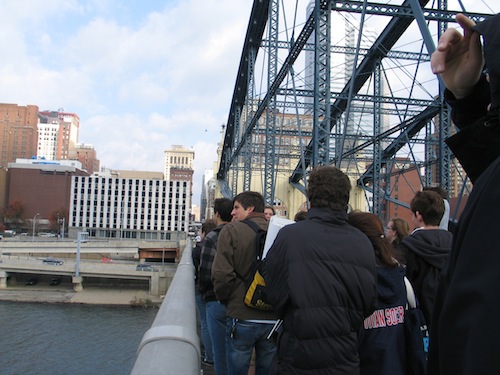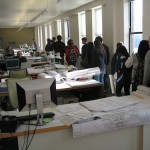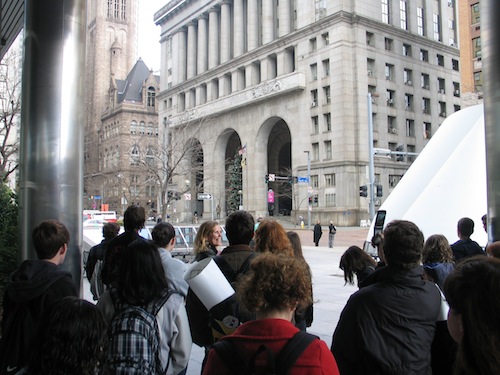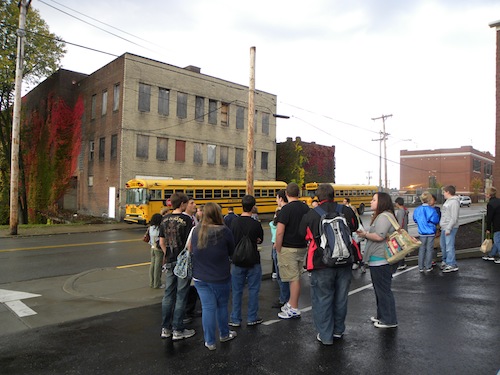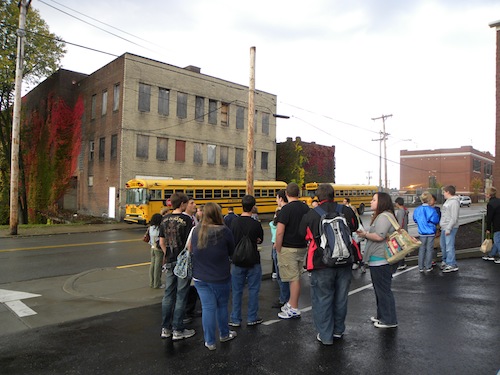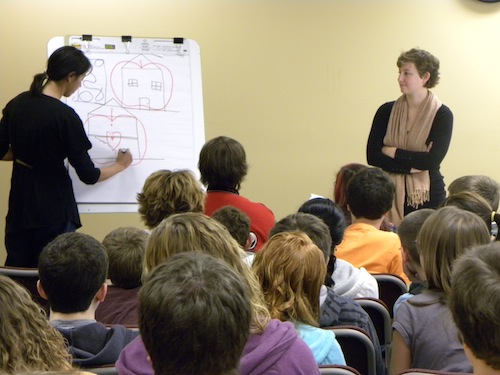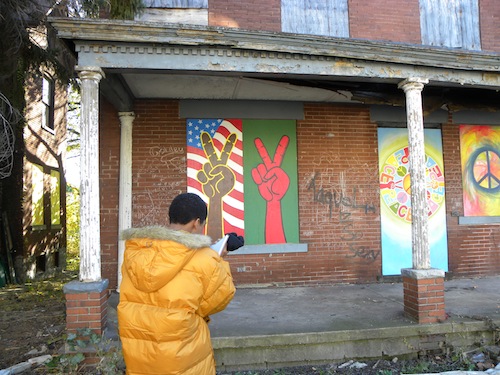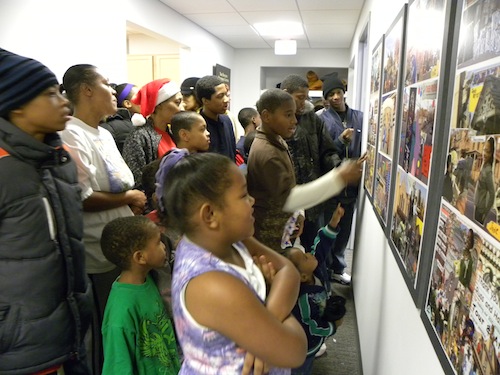
Archive: 2010
-
Jeannette Mayor Calls for Cleanup
Thursday, December 30, 2010By Candy WoodallRobert Carter stands on Jeannette’s Clay Avenue, pointing to the many, though quiet, intersections along the steep street that serves as the city’s downtown. .
“On Friday nights there used to be a police officer on every corner directing traffic,” he said.
He recalled a busy cityscape that was once a common scene throughout many of the region’s industrial neighborhoods.
“There was so much hustle and bustle here. You could get any type of clothes and cars and appliances you’d want along this street,” he said.
Finishing his first year as Jeannette’s mayor, Mr. Carter said he has worked to re-create the heyday in a city he’s called home during his 52 years.
As a self-proclaimed “man of faith” and “servant” to his city, he said he has to try to rebuild what was once a mass-production epicenter in Westmoreland County and nicknamed “the Glass City” for its many and world renowned glass manufacturing plants.
“I know we’ll never get back to that, but we can at least have it come back to a place where people can still come downtown to shop and eat,” he said.
But before the city can be rebuilt, it needs to be cleaned up, he said.
Describing his leadership style as “direct and to the point,” he began the year by replacing department heads as the city struggled in the red.
“We still had to pay bills from 2009. It became a challenge to try and run a city with zero funds, other than the budget,” he said.
Jeannette’s deficit rose to nearly $1 million during the past three years, he said.
The year’s $4.6 million budget was four weeks overdue and required more than $100,000 in cuts before it was balanced. “Every department took a hit,” he said.
The budget also included a health insurance overhaul for city employees and a provider switch from UPMC to Highmark that was expected to save about $105,000.
“We had to get everyone on the same page and let them know there would be limited spending. We were getting ready to move forward,” he said.
Moving forward wasn’t easyCity council’s first work session of the year spawned such fractious debate about the fire department’s new ladder truck that former fire chief Mike Bertolino left the meeting with chest pains and was ultimately hospitalized. He is now fine.
Then new to the mayor’s seat, Mr. Carter, a firefighter for 37 years, disagreed with Mr. Bertolino about which ladder truck should be purchased.
Using federal grant money, that truck was purchased and was expected to arrive in Jeannette yesterday, Mr. Carter said.
It wouldn’t be the last time during the year that money was at the center of debate in the city.
“Early in the year, it was suggested we file for bankruptcy, which I refused to do,” he said.
“But, yeah, the chips were down.”
In February, council approved a pre-Act 47 review as part of the Municipalities Financial Recovery Act, which provides fiscal support and recovery plans to financially distressed communities.
In July, council hired Delta Development Group Inc. as consultants for the city’s finances.
The Cranberry-based firm also did similar work in McKeesport, a Mon Valley mill town that faces similar fiscal challenges.
Through the state’s Early Intervention Program, which supplies matching grants for the work, Jeannette was able to hire the firm at 10 percent of the $81,875 cost.
Delta’s evaluation will be complete in two months, according to Michael Minyon, who began working as city clerk in March.
Some councilmen have questioned whether the city is already in Act 47, Mr. Carter said.
During a special meeting this fall, council slashed the city’s workforce to hedge against a $440,000 deficit at the end of the year.
“We had to get the budget in line and keep the city solvent,” he said.
He said Mr. Minyon had advised him and council that the city otherwise may have run out of money by November.
“Something had to be done,” he said.
Eight city employees were laid off at the end of September: three police officers, three public works staff members and two part-time parking meter enforcement officers.
“Of course it’s not what you want to do. But sometimes it’s what you have to do,” he said.
Mr. Carter and council members also refused their financial stipends for the rest of the year.
But, ultimately, it wasn’t enough to stave off a budget shortfall.
With a projected $432,000 deficit at the end of this year and $255,000 due tomorrow to the police pension fund, the city applied for a $500,000 unfunded debt loan.
A late payment to the police pension fund could result in penalties and fees to the city, according to solicitor Scott Avolio.
For every month the payment is late, a 7.5 percent penalty may be assessed, with about $17,000 in interest, he said.
The city has made payments to its pension funds for firefighters and other employees, Mr. Carter said.
First Niagara Bank first approved the loan earlier this month and was followed by approval from Westmoreland County Judge Anthony Marsili, Mr. Carter said.
The fate of Jeannette’s fiscal health is now pending approval from the state Department of Community and Economic Development, he said.
Upon final approval, which is anticipated “any day now,” the city will repay the loan during a 10-year period at $61,000 a year, he said.
Raising fees, cleaning upTo further generate revenue, council also voted this month to raise some of its fees, a move that is expected to bring in more than $300,000, Mr. Minyon said.
Earned income tax will be raised by 0.15 percent. Garbage fees will increase from $10.80 a month to $13.50 a month. And the mechanical device fee is doubling from $150 a year to $300 a year.
“These moves will help the city move forward,” Mr. Carter said.
If moving forward has been the mantra in Jeannette this year, cleaning up has been the method.
The state Department of Environmental Protection has conducted two investigations in the city during the last few months, said Katy Gresh, spokeswoman for the DEP’s southwest regional office.
Recently the DEP inspected the Monsour Medical Center property at the corner of Pennsylvania Boulevard and Route 30. The 146-bed hospital has been vacant for four years.
“It’s just been sitting there falling apart,” Mr. Carter said. “People have been going in and vandalizing it. It’s not safe.”
Medical waste and discarded needles were found on the property this fall, Ms. Gresh said.
“Public safety is of the utmost concern. We’re advising people to stay away from the facility while we initiate a clean-up,” she said.
Mr. Carter said the DEP entered the property with a search warrant, claiming it is in foreclosure and going up for sheriff’s sale in the spring.
“We’re taking care of the city’s eyesores, one by one,” he said.
Another of those eyesores is the old Jeannette Glass Co. plant.
The 32-acre property comprises two parcels between Chambers and Bullitt avenues, with its manufacturing facility sitting like a rusted monument, gnawing at Mr. Carter’s patience.
“I’d love to see it turned into an outdoor performing space, a place to bring people together, a recreational space, another place of employment, anything,” he said.
At the behest of owner Abe Zion, who bought the property for $4 million in 1983, Mr. Carter and Mr. Avolio traveled to New York in August to discuss the property — a trip that sparked debate in the city once again.
Councilman Jeff DePalma, supported the mayor and solicitor going to New York to talk to Mr. Zion, pointed out that Mr. Zion has paid more than $1 million in taxes during the last 20 years. Mr. Zion has been a good taxpayer, he said, dolling out $68,000 a year in property taxes.
Mr. Zion, 85, declined comment.
For nearly 20 years, local leaders said they tried to engage Mr. Zion in discussion, hoping he’d do something with the old facility, which is falling apart.
John Skavio, CEO of nonprofit Economic Growth Connection of Westmoreland County, said the group got close a few times, but talks ultimately went nowhere.
He last communicated with Mr. Zion in 2007, he said.
Mr. Carter said Mr. Zion first approached him at the beginning of the year with a phone call to congratulate him on his election.
He said Mr. Zion told him he wanted to do something with the property, and Mr. Carter saw it as a breakthrough.
“It’s been a long time coming, and I don’t want to miss the opportunity to get that property cleaned up,” he said.
During the August trip, Mr. Zion signed two good-faith agreements that allow the city to access his property for beautification efforts.
“I consider it a victory … .” Mr. Carter said. “It probably saved $15,000, and we still have a dialogue nobody has had with him.”
DEP steps inDEP is also working on a dialogue with him.
Inspectors took soil, air and water samples at the deteriorating site in October, while workers from the city’s health department determined the safety of the aging facilities.
Earlier in the year, DEP scientists discovered levels of arsenic in the soil to be above normal standards, and the October inspection revealed possible soil contamination from asbestos and lead, according to Ms. Gresh.
“Those substances can cause health problems,” she said.
They can also result in possible air violations, she said.
If Mr. Zion is found to be in violation, he could face fines and be legally required to clean up the property, she said.
The DEP has not yet reported its complete findings to council or Mr. Zion, Mr. Carter said.
“We’re in a holding pattern with Mr. Zion while we wait for results,” he said.
As the city works to clean up its old industrial yards, it has also tried to keep its own house in order.
At least three lawsuits have involved city employees — one with the former city clerk was dismissed in August, another involving the police chief was settled in October, while a pending lawsuit involves the fire chief.
Jeannette fire Chief Randy Dubich waived his right to a preliminary hearing on a charges in November stemming from a September incident in which a woman said Mr. Dubich tried to remove some of her clothing and groped her at the fire station when she went there to apply for a job, the complaint states.
A formal arraignment is scheduled for Jan. 26 at the Westmoreland County Courthouse.
A city fireman for 16 years who was promoted to chief in February, Mr. Dubich is now suspended without pay.
Fire Captains Mike Bertolino and Joe Matijevic are in charge of the department during Mr. Dubich’s suspension, Mr. Carter said.
Mr. Carter said he doesn’t see that kind of news as a black eye for the city.
“It’s more like a speed bump,” he said.
In the end, though, it’s all about continuing to move forward, he said.
“I’m one person who’s not afraid to say, ‘Yeah, we have issues,’ ” he said. “We also try to take a pretty active stance on those issues.
“[This year] was very challenging, but it was also very rewarding. We learned a lot and took care of a lot this year to make sure next year will be a lot better,” he said.
Candy Woodall, freelance: suburbanliving@post-gazette.com. -
Richland Farm Will Be Converted to Classrooms
Thursday, December 30, 2010By Jacob FlannickSustaining local agriculture and preserving the environment will be important areas of focus during construction of Chatham University’s Eden Hall Campus in Richland, Chatham’s president told the Pine-Richland school board at its last meeting.
Many of the barns at the 388-acre farm on Ridge Road that will accommodate Chatham’s new School of Sustainability and the Environment will be converted into facilities and classrooms, Chatham president Esther Barrazzone said Dec. 20.
The new school will offer programs such as an environmental learning lab, initiatives in sustainability and environmental studies, food studies, landscape architecture and women’s studies.
Also at the Dec. 20 board meeting, Eden Hall Upper Elementary School principal Robert Cooper brought the board up to date on the school’s bully-free initiatives.
Assistant principal Joe Domagala, guidance counselor Melissa Sullivan and fifth-grade teacher Ryan Woods participated in the presentation.
Mainly focusing on the Olweus Bullying Prevention Program, Mr. Domagala discussed the importance of a proactive approach.
“Everyone has to be on board with what we’re promoting to our school,” he said, encouraging student, parent and faculty involvement. But some board members expressed concern about the program.
Scott Stedeford said it targeted students who are too young for it, and that youngsters labeled bullies might have a difficult transition to middle school because of it.
Board President Stephen Hawbaker noted the importance of rewarding students who report bullying. “We must have our students confident in reporting things,” he said.
The board also discussed the district’s price rates for patrons to use district facilities. Board members in April unveiled a proposed schedule for charging fees to rent school facilities, including $15 per hour for a classroom, $100 per use for some athletic fields and $1,000 plus electricity for use of the high school stadium.
Jacob Flannick: suburbanliving@post-gazette.com. -
What’s next: Authorities Plan to Revitalize Jeannette
Thursday, December 30, 2010Mayor Robert Carter said he would be “trying to do more” during his second year in office in Jeannette.
He wants to get more houses up and sold along South Sixth Street. As part of a $31 million effort to revamp the city, 25 new, single-family homes and a nine-unit townhouse complex have already been built there.
He wants to raze dilapidated facilities in the city — including the old Fourth Avenue Hotel, one of the city’s earliest landmarks; its land is slated to become a parking area.
He wants the former PNC Bank property on Clay and Fourth avenues sold — which he expects will be easier with a new parking area behind it.
And, he wants to invite visitors and make sure people know that Jeannette is “a full-service city,” he said.
“We want to make this a welcoming community,” he said.
A new Dollar General store that opened on Clay Avenue this year is proof Jeannette is still a great place to do business, he said.
“What we don’t have in manufacturing anymore, we have in stores and restaurants,” he said.
He said residents of neighboring communities still visit Jeannette to eat at The Nest, a seafood and steak restaurant on Clay Avenue, and DeNunzio’s, an Italian restaurant on Lowry Avenue.
Businesses in the industrial park will join those eateries on the city’s tax rolls next year as the tax breaks expire.
With more money being added to Jeannette’s bottom line, city clerk Michael Minyon is optimistic.
“I can feel we’re starting to turn a corner,” he said.
Council approved a $5.4 million budget this month that holds the tax rate at 32.62 mills.
One mill generates about $64,000 for the city.
Council also voted this month to raise some of its fees, a move that is expected to bring in more than $300,000 to the city, according to Mr. Minyon.
Earned income tax will be raised by 0.15 percent. Garbage fees will increase from $10.80 a month to $13.50 a month. And the mechanical device fee is doubling from $150 a year to $300 a year.
“These moves will help the city move forward,” Mr. Carter said.
But he’s mindful as he moves forward, remembering the nearly $1 million deficit accumulated in Jeannette during the last few years.
“We worked hard this year to correct mistakes of the past. We don’t want to start making them again,” he said.
— Candy Woodall
-
PHLF in 2010
This year, we had more than 10,000 people participate in creative educational classes, public tours, and special events offered by our staff, with the help of many dedicated volunteers. We had a splendid “Legends and Landmarks” evening at Oakmont Country Club, where Carol Semple Thompson was honored with our Living Landmark award for her contributions to golf and preservation. We also enjoyed an evening reception at the Lehn’s historic Fifth Avenue home, honoring those who have been members of PHLF for 25 years or more.
In 2010, we fully leased Market at Fifth and we have begun to assemble the funding for a creative reuse of our fourth building downtown— the Thompson Building. Renovation is scheduled to begin in the coming months. Work in Manchester continues with the Manchester Citizens Corporation, restoring seven historic houses with funding from PHLF and the Urban Redevelopment Authority.
We also reached an agreement with the City of Pittsburgh for them not to demolish any more historic houses in Manchester until a plan is in place. We also continue to engage the City in further analysis of how to increase restoration and reuse of historic buildings in downtown.
As a result of over three years of effort by many parties, work began on the Crescent Apartment and Wilson House, for an affordable housing restoration project in Wilkinsburg. We completed all of the negotiations and acquisitions for the next phase of restoring derelict houses and planting vacant lots, and we opened our Housing Resource Center to serve Southwestern Pennsylvania homeowners with educational programs.
Our Allegheny Together Main Street program with Allegheny County has created considerable investment in building restoration, in developing new businesses, and in upgrading existing ones. The same is true for our Main Street programs in Vandergrift, Freeport, Leechburg, and Apollo. In Pittsburgh, we continue to work with North Side residents and the cultural institutions there on opening some of the historic streets in Allegheny Center.
Our Historic Religious Properties Program of financial and technical assistance was reactivated, thanks to a generous challenge grant from two PHLF members and many matching gifts from members and friends. In 2010, we accepted an easement for the oldest office building downtown, the Burke Building (John Chislett, architect, 1836), resulting in the preservation of the building’s façade in perpetuity.
The Civic Arena presented enormously complicated problems. We talked with many groups: those who feel that it absolutely must be saved; those who feel it absolutely must be demolished; the Hill District residents; the Sports and Exhibition Authority (SEA); the Penguins; and the National Trust for Historic Preservation. Ultimately, we articulated our position in the paper that we published in October 2010. We desire to see the Federal Statute called “Section 106” honored in order for SEA to see the process through to a sound solution.
All in all, I have tried to demonstrate how the foundations have been laid for a productive 2011. And, as the New Year begins, we are eager to hear from you as to your priorities for historic preservation in Southwestern Pennsylvania.
Arthur Ziegler
President
Pittsburgh History & Landmarks Foundation
-
Wilkinsburg Celebrates New Developments
On October 12th, PHLF held a press conference at the Landmarks Housing Resource Center in Wilkinsburg to announce the commencement of four major initiatives.
In the span of one year, these initiatives will bring nearly $10 million to the community and will result in two fully restored apartment buildings, three restored single-family homes which would represent the second phase of housing in Hamnett Place, the start of year three of the Neighborhood Partnership Program, and the launch of the Landmarks Housing Resource Center.
County Executive Dan Onorato, an important funder and supporter of the housing work ongoing in Wilkinsburg, stated that, “In working with these public and private partners for the last four years, we have demonstrated our commitment to the revitalization of Wilkinsburg. We have renovated homes and developed commercial property, all while preserving the historic feel of this community. We know that businesses and housing go hand-in-hand with economic revitalization.”
Brian Hudson, executive director of the Pennsylvania Housing Finance Agency, a major funder of the Crescent and Wilson restoration development, also stated that by “working together, we will be able to restore these historic buildings and not only provide affordable housing, but also provide supportive services for the new residents.”
Speakers at the press conference also lauded the success of the past two years of the Neighborhood Partnership Program, an initiative of the PA Department of Community and Economic Development, and talked about the programming for the upcoming year. With funding from TriState Capital Bank, which has committed $2 million dollars over a seven-year period, the Wilkinsburg Community Development Corporation and the Pittsburgh History & Landmarks Foundation will use the funds for initiatives ranging from vacant lot management, to programming for the Landmarks Housing Resource Center, to clean and green programs on the Wilkinsburg main street.
Lastly, the site for the press conference, the Landmarks Housing Resource Center, was praised by attendees as being a new important ingredient for community revitalization in Wilkinsburg and beyond. The HRC is located in the heart of Hamnett Place across from the Crescent Apartments. Programming throughout the year, will focus on workshops and seminars ranging from how to restore your historic home, how to acquire and improve a vacant lot, and to how to make your home more energy efficient.
-
Golden Triangle Buildings Could Get Face-Lifts
Sunday, December 26, 2010
By Mark Belko, Pittsburgh Post-GazetteThe city is looking to brighten up some “dark corners” Downtown.
Aided by a $4 million state redevelopment assistance grant, the Urban Redevelopment Authority hopes to target rundown buildings Downtown and work with property owners to upgrade them.
The project is designed to supplement a larger revitalization in the Golden Triangle that already has included the construction of the Three PNC Plaza office tower and the redevelopment of a former five-and-dime store and a department store into residential, retail and other uses.
With much of that work completed, the URA has decided to go after properties “in need of some reinvestment” — not to buy but to approach and work with the owners about making improvements.
“This is really a building-by-building, block-by-block approach,” said Yarone Zober, URA board chairman and chief of staff to Mayor Luke Ravenstahl.
Mr. Zober said the genesis for the idea came during walks he and Mr. Ravenstahl had Downtown.
“One thing the mayor and I noticed at street level were individual buildings that needed work … or didn’t have street-level appeal. They detracted from the general feel and look of the Downtown corridor,” he said.
“It became very clear that we needed new tools to continue the revitalization of Downtown.”
Funds from the grant, awarded by Gov. Ed Rendell earlier this month, can be used to make facade improvements or to address “life safety” issues that prevent property owners from using upper floors for residences or other purposes.
Life-safety improvements could include stairwells, elevators or other measures to bring buildings up to code. URA executive director Rob Stephany said such improvements typically run $250,000 at the minimum.
While projects like Three PNC, Piatt Place and Market Square Place have helped to transform Downtown, there are other buildings still in need of work, including some near the upscale Capital Grille restaurant at Fifth Avenue and Wood Street, Mr. Stephany said.
“You go to wait for the valet to bring your car back and there’s blight staring you in the face,” he said.
Properties the city initially is targeting for possible work include the Thompson Building on Market Street between Fifth and Market Square and a building owned by the Order of Italian Sons & Daughters of America at Wood and Forbes Avenue that once housed a McDonald’s restaurant.
Also on the list are three buildings at the western corner of Fifth and Wood that house a jewelry store and other retail outlets and a couple of buildings on Wood owned by the URA itself.
Mr. Zober said the URA already has had discussions with the property owners about potential improvements.
David Kashi, owner of the Fifth and Wood properties, said he hopes to secure funds to upgrade the facades of the buildings. He plans to install new windows and perhaps add a marquee to the front of the buildings. He also is thinking about placing a “big clock” on the corner building.
“We’re going to make Downtown beautiful,” he said.
Mr. Kashi said he already has had one meeting with the URA and plans to have another next month to work out plans and budgeting. He had no estimate for the cost of improvements.
He likes the city initiative.
“Downtown is the center of the whole Pittsburgh area. I think it’s about time someone took the initiative and improved the look. Nothing has changed in 50 or more years,” he said.
Improving the overall ambiance also “attracts investors to bring money into Downtown Pittsburgh,” he said.
The program will require property owners to match amounts received from the URA. Mr. Kashi is not thrilled about having to do so but said he would to increase the value and curb appeal of his properties.
The Thompson Building, which once housed the Ciao Baby restaurant, is owned by the Pittsburgh History & Landmarks Foundation, which already has redeveloped three adjoining buildings at Market Street and Fifth.
Arthur Ziegler Jr., president of the foundation, said the organization plans to restore the facade of the Thompson Building, which likely will play host to some type of restaurant, bar or cafe.
Mr. Ziegler said the building once housed a restaurant operated by the Chicago-based Thompson restaurant chain. The chain at one time had six restaurants in Pittsburgh, but the Market Square building is the only one that has survived.
It was purchased by John R. Thompson in 1926, but dates back farther than that, perhaps to the turn of the century.
“It is an important part of Pittsburgh history,” Mr. Ziegler said.
Besides restoring the exterior, the foundation will “try to meet the green standards that we’ve established down there and we want to get the building in service as soon as possible in 2011,” he said.
The foundation spent $3 million restoring the original facades of the three adjoining buildings, which house a men’s clothing store, a shoe store and apartments. It plans to make a substantial investment in the Thompson Building but also is looking for help from the URA to fill in the gap.
“We did not do that with the first three buildings. We provided the funds. We need some help with this fourth one,” Mr. Ziegler said.
Like Mr. Kashi, Mr. Ziegler believes there is a need for the type of program the URA is starting.
“I think it’s excellent. We need to continue to recognize the value of these historic buildings and improve their exteriors and their basic interiors to meet building codes,” he said.
At the site of the former McDonald’s restaurant, the city would like to remove the burnt-orange metal facade that covers the upper floors and restore the building’s original exterior.
Mr. Ziegler said that underneath the current facade the building features an attractive stone architecture. “It was a handsome corner and we would like to see it be that again,” he said.
Officials at the Order of Italian Sons and Daughters could not be reached for comment.
While the URA has targeted some real estate, any Downtown building owner interested in upgrading a property can contact the agency about possible aid, Mr. Zober said.
The city’s effort is unrelated to six acquisitions totaling $15.15 million made by an unidentified buyer on the east side of a block bordered by Wood, Fifth and Forbes over the past eight months.
While the identity of the buyer is not known, many in the real estate community believe it is PNC Financial Services Group, which built Three PNC Plaza. A PNC spokesman has said, “We don’t comment on speculation.”
There’s much talk that the block could be the site of the next big development Downtown. In the meantime, the city is hoping to fill in the cracks.
“Our goal is to really make Downtown look complete,” Mr. Zober said.
-
More than 10,000 People Participated in PHLF’s 2010 Educational Programs
-
New Tax Law Extends Charitable IRA Rollover for 2010 and 2011
On Dec. 17, President Barack Obama signed the Tax Relief, Unemployment Insurance Reauthorization and Job Creation Act of 2010. Included in the package is an extension of charitable IRA rollovers. Here are some important provisions to note:
- Individuals age 70 ½ and older may once again request direct transfers of funds from Individual Retirement Accounts (IRAs) to Landmarks without income tax on gifted funds.
- The funds must be directly transferred from IRA accounts to Landmarks (donors should ask their IRA custodians for special forms to make these requests).
- Each individual is entitled to make a total of $100,000 in gifts to charities each year under this provision.
- If you have not yet taken your IRA Required Minimum Distributions (RMDs) for 2010, you may partially or wholly satisfy that requirement through an IRA rollover gift made by January 31, 2011.
- These contributions do not qualify donors for an additional charitable income tax deduction as not being taxed on the withdrawal is worth even more than a standard charitable deduction.
- Only standard IRAs and Roth IRA accounts qualify under this law; other retirement accounts such as 401(k), 403(b), SEP, KEOGH, and SIMPLE IRA plans cannot be used to make an IRA rollover gift.
- Donors of IRA rollover gifts must receive no personal benefits from this gift nor are they available for planned gifts such as charitable remainder trusts or gift annuities.
The provision is a significant opportunity for donors who:
- Hold assets in their IRAs that they do not need;
- Would like to make a large one-time gift;
- Are subject to the two-percent rule that reduces itemized deductions;
- Do not itemize; or
- Plan to leave part or all of their IRA to Landmarks at death.
For more information on how the Charitable IRA Rollover may be beneficial to you and Landmarks, please contact our Director of Gift Planning, Jack Miller, at 412-471-5808, ext. 538 or jack@phlf.org.

